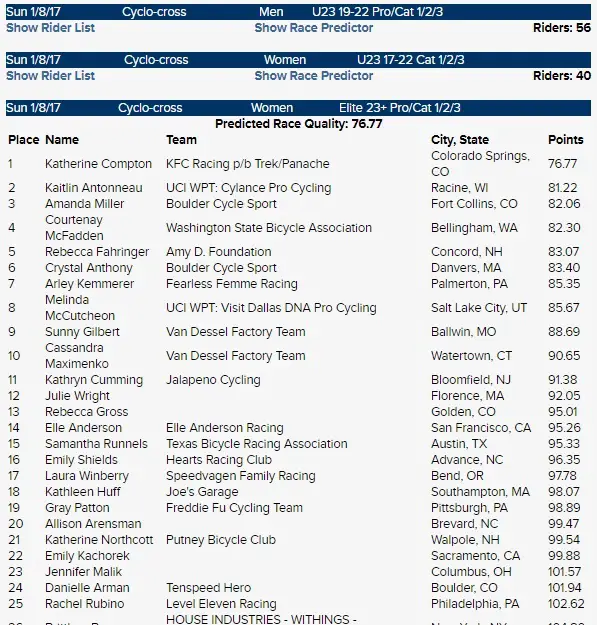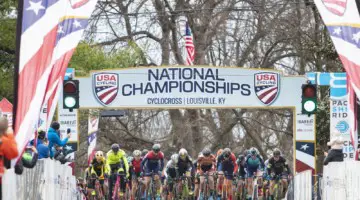It has been a while since we have featured our Wednesday Wonderings column, but a question we recently received from a reader seemed like as good a reason as any to bring it back for the upcoming season. Eric of California asked,
With Nationals in Reno, a lot of West Coasters are thinking of racing Nationals this year. However, many of our races are not sanctioned by USA Cycling, and so we are likely facing bad call-up positions. How are call-ups for Nationals done, and are there ways to help improve our ranking if we do race USAC-sanctioned races?
This is a great question. After all, going to Nationals is a season-long goal for most racers, so it is natural to want the best possible racing experience, which includes a call-up position commensurate with your racing ability. Call-up positions at Nationals are based on the USA Cycling ranking system, which only gives points for races sanctioned by USAC. The dilemma of Nationals call-ups is not new, with West Coast riders such as Don Myrah and others having to fly across the country to make sure they have enough points to qualify for good call-up positions at Nationals.
A good USAC ranking may earn you the opportunity to be featured in one of the famed Cyclocross Magazine Sporza-style start line videos at Nationals.
So what is a Masters rider to do? One option is to pull a Sagan and hope you can blast through the field to the front right after the whistle. Another is to make a season-long commitment to racking up good ranking scores to help make sure you get a grid spot that does not leave you squinting to see the front row.
For today’s Wednesday Wonderings, I am going to address Eric’s question by channeling my inner-Nate Silver and looking at how the USAC ranking scores are calculated. I will then offer some “ranking hacks” based on how the numbers and my experience of chasing good ranking scores during my days as a mediocre Cat 3 racer. [See also: Part 2 – Confessions of a USA Cycling Points Chaser]
Even if you are not planning on racing Nationals this year, there is still value in understanding how ranking scores are calculated, especially if you race is a scene with a lot of riders or are planning on competing at some of the regional UCI-weekend races. Many of these used either the USAC rankings or those developed by crossresults.com to do call-ups.
I am going to focus on USAC’s ranking system, although many of the same principles likely apply to the crossresults.com rankings, especially since the USAC system is based on the one developed by Colin Reuter. USA Cycling actually has two points systems: upgrade points and ranking points. Upgrade points are awarded to riders who finish in the top three to seven spots—based on field sizes—and are used to determine when riders need to upgrade. I am not talking about upgrade points here today, although they are worth being aware of, lest you be accused of being a bagger of sand.
How I Learned to Stop Worrying About My Ranking and Love the Math
USA Cycling’s rankings are a score between about 70 and 600 that, in theory, allows riders from across the country to be compared against one another. Similar to golf, the lower the score the better. For reference, Stephen Hyde and Katie Compton are currently the top-ranked man and woman, with scores of 73 and 77, respectively.
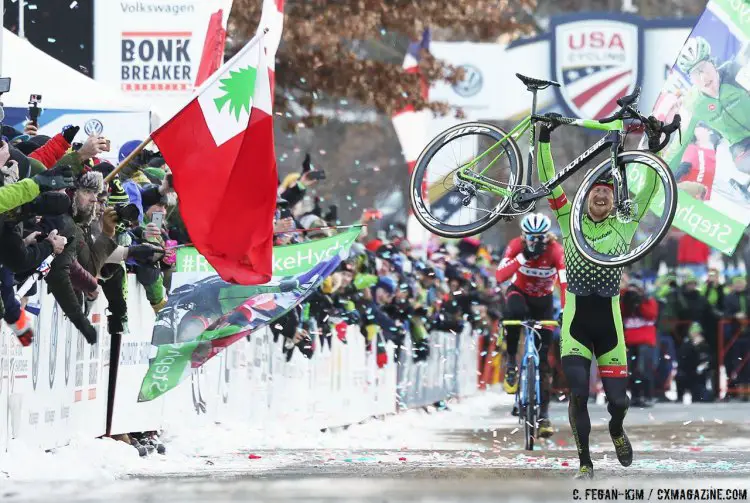
All ’crossers wish they could “Ryde like Hyde” when it comes to USAC ranking points. 2017 Cyclocross National Championship, Elite Men. © C. Fegan-Kim / Cyclocross Magazine
Each USA Cycling license holder has an overall ranking score that is calculated by taking the average of their top five race scores from the last 365 days. DNFs are given zero points and if a rider has less than 5 races, the maximum score of 600 is given for each missing race. For example, if a rider has only done three USAC-sanctioned races, the other two races will each be given a score of 600.
Points are awarded on a race-by-race basis and are continually updated after each week of racing. This is important because if riders like Eric are joined by a lot of other riders with new licenses, their scores for early-season races will slowly improve as riders do more sanctioned races. The points awarded for a given race are determined based on both finishing position and overall quality of the field, so from a scoring standpoint, there may be more utility in getting your face smashed in in a UCI race than podiuming at a local race. I will discuss this shortly.
There is a formula for calculating the USAC ranking points. The math is not super-complicated, but I will still save you the details and focus on two key factors used to determine a race’s ranking points. More details on how points are calculated are available at the FAQ page from USA Cycling.
The first is the “Race Quality.” The Race Quality is the low score awarded to the winner of each race, and it is used as the basis for calculating scores for all the other racers. It is calculated by averaging the overall rankings of the best five of the top ten finishers for a given race and multiplying that number by 0.9, but it cannot be lower than the overall ranking of any of the top ten finishers. It is obviously hard to predict the future, but it is probably safe to assume the Race Quality will be equal to the overall score of the top-ranked rider registered for a given race.
How do you know how riders are ranked before the race? The usacycling.org website lists who is registered for each race and provides a “Race Predictor” that ranks all registered riders based on their USAC rankings. It makes things rather easy.
The second important part of the equation is the average ranking of all finishers.
We know the score awarded to the winner of a race, but as they say, there can only be one winner. Most riders are going to finish somewhere in the middle of the pack. If you are chasing ranking points for Nationals, here is where things get interesting. If I were trying to decide which races to target, I would probably want to know the absolute worst score I could possibly receive to get a general idea of the quality of the field.
The worst possible score for a race can be calculated using the Race Quality and average of riders. The equation is Worst = Average + [Average – Race Quality] or 2*[Avg] – [RQ]. The worst possible score for everyone who finishes is 590 points, so this may slightly affect the race points, but not by much.
Going back to our original Wednesday Wondering question, Eric was asking how he and his friends can best target races to get a good call-up position at Reno Nationals. For reference, I compiled a list of the overall USAC ranking scores riders should be targeting based on the fields from the Hartford Nationals. For the Men, the scores indicate a start position in the first two rows and for the women, the scores are for a front row start.
USAC Rankings - Hartford Nationals
| Category | Men (First Two Rows) | Women (First Row) |
|---|---|---|
| 30-34 | 137 | 149 |
| 35-39 | 141 | 151 |
| 40-44 | 124 | 136 |
| 45-49 | 132 | 158 |
| 50-54 | 132 | 176 |
| 55-59 | 154 | 240 |
| Singlespeed | 117 | 157 |
Five Easy Hacks for Improving Your Ranking
The scores of riders who received good call-up positions at Nationals are pretty low, so there is no “one easy trick” for getting a front-row call-up at Nationals; you have to be pretty good at riding your bike. Still, there are some neat tricks riders can use when targeting events to travel to if they are interested in racking up quality USAC ranking scores.
1. Try to avoid open fields or even 1/2/3 fields.
One obvious temptation for Masters racers is to race both their Masters age group and the Elite race on the same day. It provides two scores on one weekend, and that Elite field probably has really good ranking points for the taking, right?
Not always. Winning these races often provides good ranking points since most scenes have at least five, if not many more, outstanding riders. However, outside the podium spots, the points are dictated by the average ranking of the field. For open fields, this likely means a lot of riders with scores in the 400s and above, and even for 1/2/3 fields, there are likely a lot of scores in the 300 and 400s. This means that just entering the Elite race may not yield a good score; you actually have to race well.
As for the question of whether to do Masters or Elites, a brief review of some selected scenes suggests it can really vary. There are some very strong Masters fields, especially in places like Colorado, so it may be better to race Masters in those locations.
If you are considering an event that’s previously been held, I recommend looking at the scores from the previous year’s race to get an idea of what kind of point distribution you can expect.
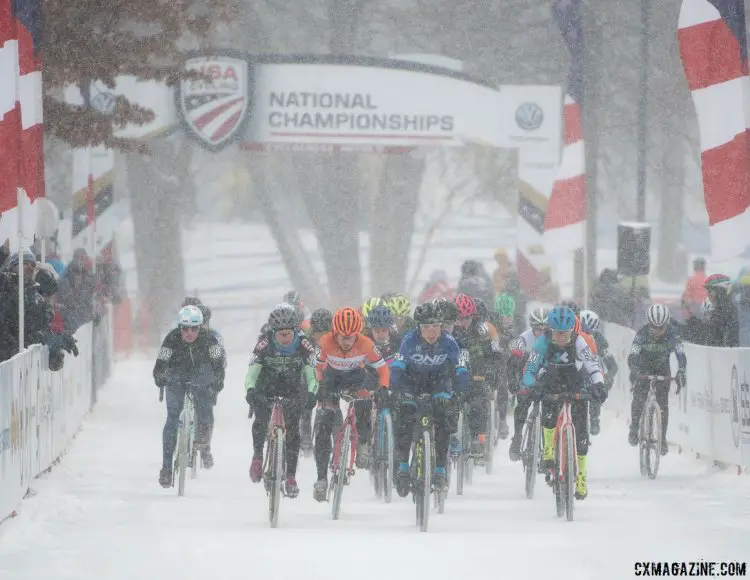
Starts are always hectic, so it is logical to want to start near the front. 2017 Cyclocross National Championships, Singlespeed Women. © A. Yee / Cyclocross Magazine
2. Get a UCI license.
Probably the best strategy, if your ego can handle it and you have the proper USAC category ranking, is to get a UCI license and target some of those races. UCI races are restricted to Cat 1 and 2 riders, so the field averages for these races are likely to be low. Most Cat 2s pass on these opportunities to get shelled, so there is less risk of riders with high ranking scores dragging down your points earned at the race.
Of course, if you are a strong racer living in a non-USA Cycling region, you could still be a Cat 4 or 5 by USA Cycling’s standards, making UCI racing not an option. Your first goal is to be to upgrade to Cat 3 to qualify to line up in Reno.
The following table takes a look at ranking scores from some of the 2016 UCI races in the western part of the country. Scores earned by the rider in the exact middle and last-place positions are given for both the Men’s and Women’s races. These scores are not necessarily indicative of what they will be in 2017 though. CXLA and Ruts ‘n’ Guts were both held at the beginning of December when the top U.S. riders were waiting to travel to Europe for the Namur and Zolder European block, while this year, CXLA is being held the same weekend as a World Cup, which will likely affect who decides to race and thus the quality of the fields.
2016 West Coast UCI Race Rankings
| Race | MEN - Middle | MEN - Last | WOMEN - Middle | WOMEN - Last |
|---|---|---|---|---|
| West Sacramento GP | 369 | 600 | 373 | 590 |
| US Open of CX - Day 1 | 144 | 212 | 151 | 216 |
| US Open of CX - Day 2 | 132 | 187 | 142 | 200 |
| Tulsa Hurtland | 139 | 179 | 229 | 358 |
| CXLA - Day 1 | 134 | 195 | 170 | 270 |
| CXLA - Day 2 | 140 | 209 | 131 | 194 |
| Ruts 'n' Guts - Day 1 | 96 | 118 | 107 | 141 |
| Ruts 'n' Guts - Day 2 | 96 | 116 | 114 | 154 |
It is likely not applicable for West Coast riders, but I also took a look at the East Coast Vittoria series, and in 2016, a male rider who finished 40th in every race would have a score of 149 and if he finished last, his score would be 171, which is good enough for a start in the 4th or 5th row of the Masters fields at Nationals. For women, these scores are 121 for finishing 20th at every race and 162 for finishing last. A score of 162 is good enough for a Masters 2nd-row start at Nationals. These are illustrative of the benefits of racing in the UCI fields—and living on the East Coast.
3. Avoid races a lot of other non-USAC West Coast riders are going to race at.
Riders are given a score of 600 for any race less than the five used to calculate USAC rankings, so races with a lot of West Coast riders are likely to have really high average scores. It’s a vicious cycle, sadly, as racers in non-USAC regions will flock to rare USAC races in search of upping their ranking, but as a result, bring the average score down. This concern will be somewhat mitigated as the season progresses since the USAC system continually recalculates scores for each race.
However, there are likely to be racers who purchase a USAC license, do two races and then decide to stop chasing points. Their scores are going to be there to inflate race ranking points and serve as a drag on those looking for good scores. I would probably shy away from targeting these races, although that does mean you will probably have to travel further into the depths of a USAC-sanctioned country if you’re serious about chasing a good start position, however expensive or impractical that is.
4. Organize a race and pay the ten best riders in the country to attend.
If all else fails, you can offer Katie Compton, Katerina Nash and company a ton of cash to come to your own personal race. If you have no USAC races in the past year and invited the top ten women in the country, you would receive a score of 181 for the race. Do a three-day mega-weekend and you are well on your way to a great call-up at Reno Nationals.
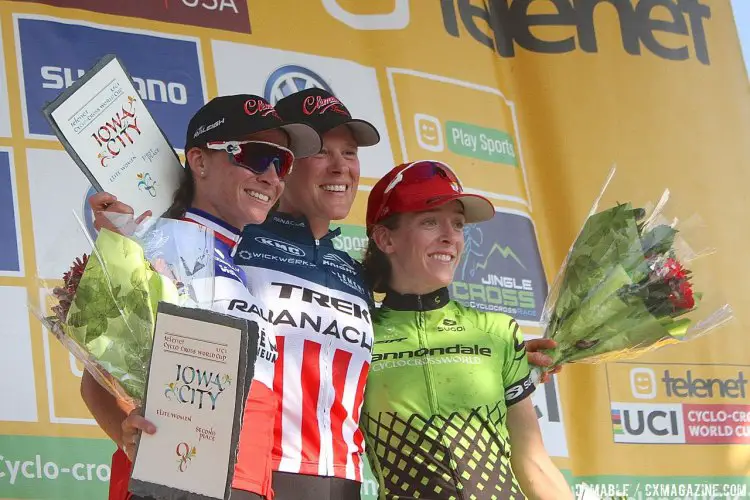
If all else fails, put on a race and invite Katie Compton and friends to score some good USAC ranking points. 2016 Jingle Cross World Cup, Elite Women’s podium: L to R: Caroline Mani, Katie Compton, Kaitie Antonneau. © D. Mable / Cyclocross Magazine
5. Work on Your Starts.
Does this all seem too complicated and convoluted just to move up a few rows at Nationals? While racers making a Nationals podium a season-long goal might justify the chase, the rest of us can just practice our starts and study Lars Boom and Peter Sagan to improve our position within just a few turns. You might end up spending more time on your bike and end up stronger because of it. That cannot hurt your chances for Nationals success.
I hope this primer on the USAC ranking system was useful for Eric and all his West Coast friends looking to race their age group at Nationals this year. And for everyone else, maybe the look under the hood at how the points are calculated will help you better understand those weird numbers next to your name on usacycling.org.
Happy ranking points hunting.
Don’t miss: Part 2, Confessions of a USA Cycling Points Chaser.
Have a question or topic you’d like us to explore (in far greater detail than you might want)? Submit it below.













